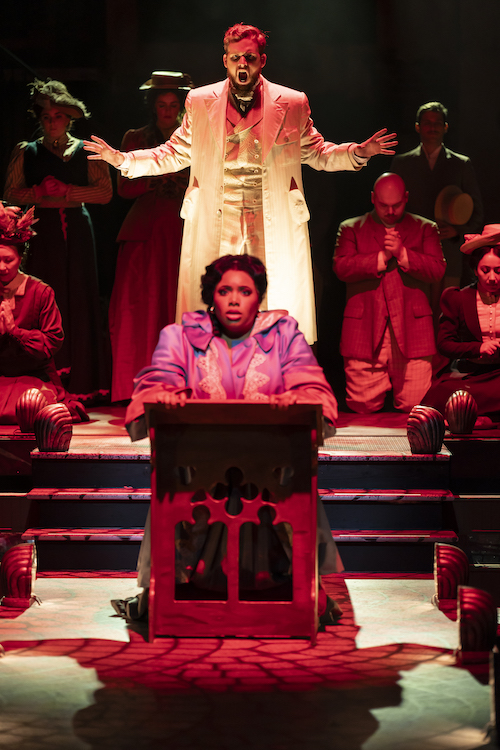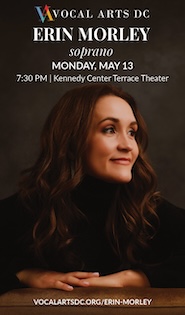Singers soar as angels and demons do battle in Wolf Trap’s “Faust”

Brittany Logan as Marguerite and William Clay Thompson as Méphistophélès in Gounod’s Faust at Wolf Trap Opera. Photo: Scott Suchman
The summer season is heating up at Wolf Trap Opera Company, with a superbly cast production of Gounod’s Faust.
Admittedly, the small pit in the Barns hamstrung the sound of the orchestra, which was scaled down to chamber size opening night on Friday. As a result, this melodramatic opera’s climaxes, last heard in the full version at Washington National Opera in 2019, were largely vocal in nature.
The medieval legend that inspired Goethe’s source play concerned a scholarly scientist who sells his soul to the devil for youth and knowledge. Gounod and his librettists filtered the story through Michel Carré’s play Faust et Marguerite, thus heightening the role of the young girl seduced by Faust with diabolical assistance. The work concludes with the imprisonment of Marguerite, who has killed her child by Faust, and the salvation of her soul.
Indisputably sitting atop this fine cast was the stellar soprano of Brittany Logan, whose Marguerite was indeed worthy of having her bow follow the title character’s at the curtain call. Hailing from Baton Rouge, Logan was a Wolf Trap studio artist in 2021, covering roles and singing in the chorus, and has been trained in the Lindemann Young Artist program at the Metropolitan Opera since then.
Hers is a voice with irresistible power and consummate control. Logan nailed every vocal aspect of this daunting role. Delicacy and high-flying acrobatics abounded in the Act III garden scene: melancholy legato in the “King of Thule” ballad, matched by vibrant trills and athletic articulation in the Jewel Song. Her strong acting and characterization mined the character’s fraught development, from shy innocence to sparkling coquetry to despairing madness. Even by the end of Act V, Logan’s voice remained indefatigable, rising step by step to radiant high Bs on the repeated line “Anges purs, anges radieux.”
As Méphistophélès, William Clay Thompson displayed an imposing bass, stronger in the baritonal heights than in the deep register. His Act II showpiece “Le veau d’or” and Act IV mock serenade (“Vous qui faites l’endormie”) revealed diabolical power and subtlety in his interpretation. He embraced the more over-the-top elements of the staging, wearing a horned mask in the witches scene of Act V, set in a bordello.
Tenor Eric Taylor made an excellent showing in the conflicted nature of the title character, both earnest and rapacious. His top notes rang with clarity, although the attempts to decrescendo subtly at some of those points revealed occasional raggedness. Mezzo-soprano Mary Beth Nelson proved a superlative Siébel, with a smoothly joined voice from bottom to top in the trouser role’s signature aria, “Faites-lui mes aveux” in Act III.
After a believable male role in last month’s Semele, mezzo-soprano Kathleen Felty showed remarkable range in the supporting role of Marthe, Marguerite’s nosy neighbor. Her comic interactions trying to seduce both Siébel and Méphistophélès were a highlight of the opera’s lighter side. Baritone Kyle White sang sympathetically as Valentin, Marguerite’s brother, but the refinement and polish of the voice are still developing.
This year’s crop of Wolf Trap studio artists filled out the chorus in small but valiant numbers, often sufficient in power but lacking a grand opera breadth of sound in large scenes. Assistant chorus master Michelle Papenfuss gave a churchy flavor to the chapel scene on amplified electronic organ. With only one of the score’s paired woodwind parts, two of the four horns, no trombones, and one of the four harps, the Wolf Trap Orchestra paled in volume at crucial climactic moments.
Due to a central platform extending into the audience, returning conductor Geoffrey McDonald was forced to lead from a podium on the far house-right side of the narrow pit. Raised up slightly so that his sweeping, grandiose gestures could be seen by the singers, he was a great distance from the woodwinds and brass. Remarkably he kept a sure sense of ensemble throughout the evening, putting Logan back on track after an early entrance at one point.
Director Alison Moritz’s production transposes the action to New Orleans at the turn of the 20th century, with a set evoking the railed balconies of the French Quarter (designed by Lawrence E. Moten III). Faust is shown as an aging alcoholic writer in Act I, pecking away fruitlessly at a typewriter, Siébel as a nerd in a boater hat, and Méphistophélès as a southern gentleman in a white suit, complete with cane and top hat (costumes by Lynly Saunders).
A sign showing the handwritten address of Marguerite’s home, 1020 Rue Saint Ann, refers to the one-time home of Marie Laveau, known as the Voodoo Queen of New Orleans. A free granddaughter of an enslaved woman brought to Louisiana from Africa as a child, Marie was the illegitimate daughter of Marguerite Laveau, after a fleeting liaison with a man she thought was in love with her. The parallel could explain the ability of Gounod’s Marguerite to drive away the devil at the end of the opera.
Faust runs through July 29. wolftrap.org



